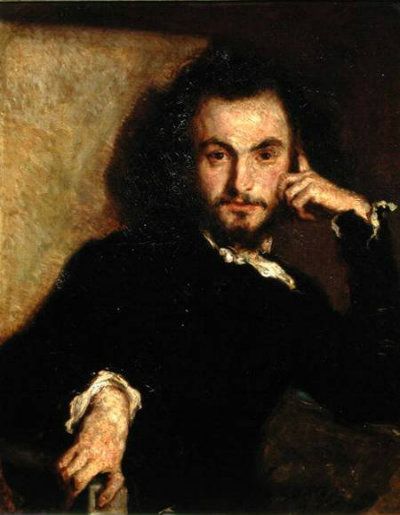James Tissot, Charles Baudelaire, and Fashion: Baudelaire on Fashion
7:02 AM
Portrait of Charles Baudelaire by Emile Deroy, 1844. In the collection of the Musée national des châteaux de Versailles et de Trianon.
Tissot’s London paintings provide a detailed and nuanced look at contemporary society. He captures ‘modernity’, a word coined by Baudelaire in The Painter of Modern Life (1863). For Baudelaire, an important element of this modernity was the correct representation of contemporary fashion. He writes:
“The draperies of Rubens or Veronese will in no way teach you how to depict mouire antique, satin a la reine or any other fabric of modern manufacture, which we see supported and hung over crinoline or starched muslin petticoat… Finally the gesture and the bearing of the woman of today give to her dress a life and a special character which are not those of the woman of the past. In short, for any ‘modernity’ to be worthy of one day taking its place as ‘antiquity’, it is necessary for the mysterious beauty which human life accidentally puts into it to be distilled from it.”
Baudelaire places emphasis on fashion and beauty, citing it as one of the key visual indicators of modernity. He argues that for a work of art to take its place in the annals of history, a human essence and sense of life must be present. The artist can best portray this intangible concept through capturing his surroundings, for example, the clothes, gestures, and particular beauty associated with that particular moment in time. It is that which the artist is most familiar with, which the artist truly understands, because that is the context in which the artist lives. As Nancy Rose Marhsall summarizes, “The clothing of the body in fashion, a procedure representing its socialization, worked to locate the female form in a particular moment, removing it from the realm of the ideal and investing it with cultural and historical specificity—with modernity, in fact, which Tissot embraced.”
Baudelaire places such an emphasis on fashion because he associates it with the essence of humanity itself. The artist must represent contemporary fashion because fashion is an essential part of humanity, and it is through fashion that this can be seen. He particularly focuses on women, writing:
“Everything that adorns woman, everything that serves to show off her beauty, is part of herself; and those artists who have made a particular study of this enigmatic being dote no less on all the details of the mandus muliebris than on Woman herself… What poet, in sitting down to paint the pleasure caused by the sight of a beautiful woman, would venture to separate her from her costume?”
Baudelaire's arguments have since become one of the key theories in the field of fashion history, but I believe that is a topic for another post.




1 comments